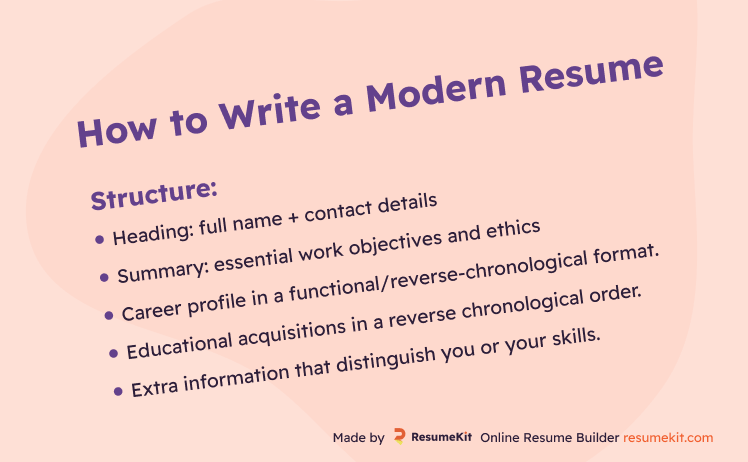So you heard about an amazing job offer that pays a lot more than you get at present. Naturally, you make preparations about getting in line for the job. You match the job requirements with your skills and achievements.
You even rent a business-oriented suit so you can look serious during the interview. But what about your modern resume?
If you are like many job seekers, the quality of the resume you present to HR is the least of your worries. You assume that the interview will get you more points than an enumerated list of ‘can dos’ and ‘have dones.’ At best, you are only half-right.

Maybe there was a time when resumes did not matter for job procurement. However, the present is not one of such times. So, to fit into the category of best job applicants, you need to know the modern resume format. If you don’t, you need to scour the internet for modern resume examples to get a feel for them.
Nevertheless, whether or not you have found such examples, you are in the right place. This article is all about giving you useful tips to help you develop useful, job-procuring modern resumes.
Table of Contents
What is a Modern Resume?
From the notes you will find at Top Resume Formats, a modern resume contains the most essential information about you. This information is not only the most essential but the most relevant for certain job requirements. In other words, modern resumes are crafted in such a way as to present you as qualified for job offers.
You may now be asking, “What is the difference between a traditional resume and a modern resume?” This is a valid question. A traditional resume, by definition, is a generally simple presentation of your information. It contains personal data like date of birth and also particular data like career development and proficiency.
A traditional resume is traditional because it is not as structured as what we have in modern resumes. You can think of a traditional resume as very broad and unspecific. What you really do with traditional resumes is shout, “Do me! Choose me! I can do everything!” A modern resume is different.
With a modern resume, purpose and structure are the fundamental characteristics. They support each other and lend credibility to your application. A modern resume is not broad in the way that traditional resumes are. Instead, it consists of 2 pages, at most, with paragraphs that hit at the center of your application.
What Should a Modern Resume Look Like?
To understand modern resumes, let us see what they look like.
A typical modern resume has the following structure:
- A heading with your full name and contact details.
- A summary with the most essential work objectives and ethics properly highlighted.
- A work/professional/career profile with your skills documented in a functional or [reverse] chronological framework.
- A section on your educational acquisitions, also in a [reverse] chronological order.
- Extra bits of information that distinguish you or your skills in ways relevant to the job posting.
Each of these sections, mind you, is not presented in a general or generalized format. One of the peculiarities of modern resumes, relative to traditional resumes, is deliberateness and purpose. Every section highlighted above is driven by a proper understanding of what the job requires. This is where you find resumes focused around particular themes instead of everything.
Here is an example.
Imagine that you are applying for a janitor’s position in a newly-built university. A traditional resume will include everything about you, including that you used to be a bouncer at a nearby club. A modern resume will only focus on the most relevant information and characteristics, such as physician resilience and toughness of mind.
By this principle, a modern resume looks like it was tailored for that particular job. And it should be. This is why traditional resumes are no longer in vogue. Pertinence and suitability are the pillars of modern resumes, not universality and rigidity.

Writing a modern resume can be fast and effective with the Resumekit AI resume builder. Artificial intelligence can write you some core sections like resume objective and summary and save you so much time.
Writing Your Resume Introduction
Knowing what you know now of the makeup of modern resumes, how do you go about implementing them? Let us start with resume introductions.
First, a resume is historically a summary of who you are and what you can do. A modern resume introduction is a resume of a resume. In other words, it is a summary of the summary of who you are and what you can do.
However, how you craft this summary is entirely dependent on the job in question and its requirements.
Your introduction in a modern resume should include your qualification, area(s) of expertise and interest, and ultimate objective. All of these should be at most 100 words, including a bulleted list of the areas of your expertise.
Regarding language, you cannot — rather, you should not — write in a style that is too flowery, too formal, or too informal. Being stiff in your writing style does not help either. You also have to be stingy with your metaphors and figurative expressions.
Also, please do not copy the words from the Ballad of the Frogman. No HR is interested in a “… rootin’, tootin’, lootin’, shootin’, parachutin’, double cap cripping’, scuba-diving…” applicant. Be as straightforward and concise as you possibly can.
With modern resumes, too much emphasis on any one thing is a turn-off. So, avoid using ‘professional’ after every 4 words in your introduction.
How to Format Your Resume and What Styles to Use
Resumes are very special reports. They are not like any other kind of writing or presentation. In many ways, resumes are in a category all by themselves, and this is because of their purposes.
If you have seen a resume, traditional or modern, you would have noticed that it has a particular formatting style. For one, the paragraphs don’t just read on and on. Instead, there are as many breaks as the page would allow. This is the normal (better yet, traditional) formatting form that resumes often take.
Modern resumes are not altogether different from traditional resumes on this front. They are also made up of sections and short paragraphs. If we can point out a characteristic formatting element in a modern resume, it would be a target-driven organization. By this, we mean that there is no one-size-fits-all structure. Instead, your formatting takes form based on the information you have available and the job requirements.
A typical resume has an introduction/summary, and sections on work/career, skills and accomplishments, education, and others. However, in a modern resume, it matters what and which section comes first.
If, for example, you don’t have enough working experience, your resume format and style should not emphasize a professional career. A well-written section on educational acquisitions could come first, and then the section on Work and Career Profile. And if you happen to have skills that match the requirements of the job, even perfect. Let the section on Skills and Accomplishments come first.
Also, the font you use for the entire resume is very important. You can get more information on the best fonts for winning resumes from ResumeKit here.
Things to Note About the Skills and Accomplishments Section
After the resume introduction, the section about your skills and accomplishments is likely the most important. The introduction gets HR interested in your resume and you, but this section stimulates them to invite you for an interview. Thus, you absolutely cannot mess up this part of your resume since it gets to the heart of what you can offer.
Now, there is no specific structure to the Skills and Accomplishments section in a modern resume. In fact, here is where you are allowed some breathing room for innovation and flexibility. However, you must be guided in your flow or you could end up undermining yourself or crippling your prospects.
The first thing you should note about the Skills and Accomplishments section is that organization is key. Skills are generally divided into hard (or technical) and soft skills. You must keep this division in mind and use it to your advantage. A clever application is to list your technical skills first and follow it with another bulleted list of your soft skills.
Concision and precision are must-haves for your Skills and Achievements section. So, use active verbs instead of passive verbs, and list skills and outcomes instead of activities.
If you need extra information on this point about the Skills and Achievements section, check out ResumeKit’s suggestions on solid modern resumes.
Some Notes On Keyword Optimization
Keyword optimization is possibly the most distinguishing characteristic of modern resumes. What does this mean? Keyword optimization is simply maximizing your chances by using words that match the requirements of the job. It is also the deliberate use of terms that make your resume stand out. Thus, to optimize keywords in a modern resume is to include terms and expressions that call attention to you.
Of course, these keywords are not random. You can’t go using ‘supercalifragilisticexpialidocious’ in your resume and expect to get a reasonable response from an employer. That is not a keyword, not unless you are applying to play the part of Mary Poppins. Keywords are particular to each job offer, so you have to make a note of them and use them.
At present, many employers use ATS (short for Applicant Tracking Systems) to select potential candidates for employment. These are software applications or algorithms that riffle through applications and select the most suitable. The selection process is based on how well-matched applications (resumes, really) are to the job’s requirements. However, the operations of ATS generally revolve around keywords.
So, when writing a modern resume, make sure you use appropriate keywords. You can get this on the job listings or the employer’s website.
Incorporating Social Links

This is a new world and a lot of our daily activities revolve around what is on the internet. Virtual life has so mixed with the natural plane that they are now somewhat inseparable. This inseparability also has some influence on how effective you make your resume.
Unless you are a hobbit or from Harry Potter’s wizarding community, you use the internet. This means you have at least one social media account. Facebook, Twitter, LinkedIn, Instagram… any of these social media platforms can raise or ruin your chances at employment. This is why you must know how to properly incorporate social media links into your resume.
First, you ought to have a social media account. Such accounts lend more credibility to your claims as a real person with real skills and achievements. LinkedIn, especially, is an online platform designed for all things career-related. There you have a history of work, a list of achievements, and more. You could even copy some of those achievements and use them as a guideline for your resume.
The point of using social media links is to validate your skills and everything else you claimed in your resume.
This reduces the need to go on and on about yourself in the resume. If your introduction is good and your Skills and Achievements section is on point, you can put your social media account to great use.
However, please don’t include a social media link in your resume if the account paints you in a negative light.
Remember, the operative word is PURPOSE. So, if your social media accounts do not serve this purpose, leave them out of your resume.
What About the Length of the Resume?
Lastly in this article about how to write a modern resume in 2022 is the issue of length. How many words are good enough for job-securing modern resumes? How many paragraphs and pages?
Ideally, two pages are okay. Any more is too much and a page is too few (although there are exceptions). It all depends on the job listing. So, as long as you have the necessary sections in short paragraphs of 50-70 words at most, you are good to go.
All in all, you can rely on well-written modern resumes to get you the job 9 times out of 10. Unless there is some other criterion at work that you don’t know about, expect to get an invitation for interviews.